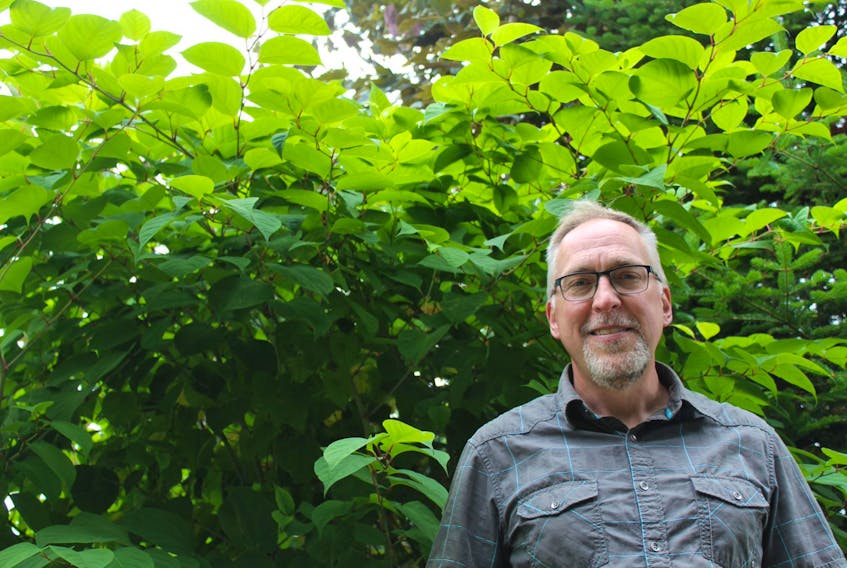ST. JOHN'S, N.L. — While strolling in Memorial University’s Botanical Garden’s nursery, horticulturalist Todd Boland points to three large plants in close vicinity, each with dense layers of heart-shaped leaves and bamboo-like stems that tower over Boland’s head at nearly seven feet tall.
Underneath the leaves peeks a handful of dead Irises, brown and wilting.
“The plant just wants to take over,” Boland said.
The plant he is referring to is Japanese knotweed, and it is listed by the International Union for Conservation of Nature as one of the 100 worst invasive species.
Across Canada, cities have started programs to eradicate Japanese knotweed, whose roots can grow three metres deep and seven metres out, and destroy native plants and infrastructure.
An infestation of the weed can knock thousands of dollars off a property’s value due to the damage it can wreak on building foundations and buried pipes.

It is established across Newfoundland — cracking driveways and overtaking the banks of the Waterford River and neighbourhood gardens. There are no programs fighting back against Japanese knotweed.
The plant, native to East Asia, was introduced to Newfoundland as an ornamental plant and as a way to stop erosion of riverbanks, since the roots are extremely strong and stable in the ground.
Later, they were used as privacy hedges, and kids would use them as fake blowguns for peas and rocks.
But little did people know how invasive it would become, Boland says.
“It out-competes,” Boland said. “It goes from nothing to 6 to 10 feet in one growing season. Essentially, they just shade out everything underneath them.”
The 50-foot garden bed Boland spends his days pulling the dried Japanese knotweed out of is no longer fit to use, because the knotweed will “choke out” other plants with its massive roots.
He says if people find a young knotweed plant on their property, they shouldn't wait to start getting rid of it, but be mindful when they do.
“It seems like knotweed spreads by little pieces of roots,” Boland said. “So, in fact, when people are churning it, trying to dig it up, they are actually helping it to spread.”
Boland says he has heard Roundup is an effective way of taking out the torment, although it takes years.
He says fighting back against these invasive plants would be a “sisyphean task,” so instead locals are making good of the weeds with crafty solutions.
Tasty torments
“It’s not just a weed,” Shawn Dawson, a forager and owner of Barking Kettle, said about Japanese knotweed.
“I think knotweed is one of the coolest weeds. It’s the weed of a thousand names.”
Locals know Japanese knotweed as pea shooters, mile-a-minutes, September mist — for the white flowers it sprouts in September — and many other names.
The best way to get back at these dreadful weeds is to eat them, Dawson says.

“It tastes like sour rhubarb and has an after-taste of apple,” Dawson says. “It’s a super food and has a huge number of antioxidants.”
If you’ve had a bite to eat at Raymonds, Merchants Tavern, Grounds Café or Mallard Cottage, chances are you have tasted some of the Japanese knotweed Dawson foraged.
Dawson won’t take any of the Japanese knotweed people may find in their garden, mostly because he can find all he needs on his own.
“It is so invasive that I am able to go out for a day and collect enough to sell to the restaurants,” Dawson said. “I’ve made a couple hot sauces myself with it, and I actually had a Japanese knotweed milkshake at Raymonds.”
Milkshakes and hot sauces are a great way of using the menacing plant, but there are more inedible ways being explored as well.
Knotweed, not weed
Felicity Roberts, a local forager and wild-food activist, was drawn to exploring the uses of Japanese knotweed because “there is so much of it everywhere.”
“Invasive species present challenges to native species and biodiversity in general, but so does chemical warfare and aggressive removal tactics, so our actions must be weighed carefully,” Roberts said.
These abundant invasive species also present abundant opportunities, and for Roberts it is personalizing clothing.
“Japanese knotweed provides a beautiful plum to rose-gold dye for fabrics. They provide easy and plentiful biomass, if we can figure out where to direct it, and without the need for fertilizer and excessive water that many cultivated crops require,” she said.
It can also be turned into paper, is a promising source of biofuel and is being used to treat Lyme disease, she added.
[email protected]
Twitter: @JasmineBurtNL









